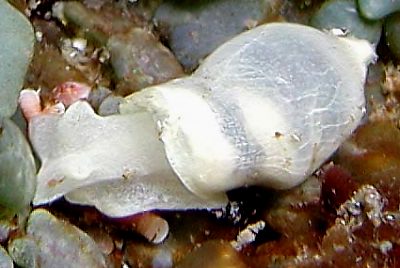
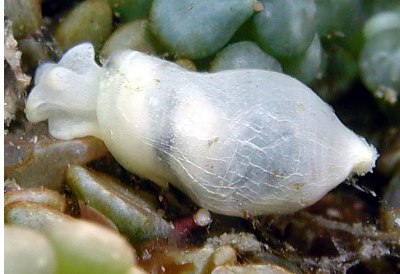
Volvatella ayakii
Hamatani, 1972
Order: SACOGLOSSA
Superfamily: OXYNOOIDEA
Family: Volvatellidae
DISTRIBUTION
Known only from Japan.
PHOTO
Hachijo Island, Japan, 8m, 3 March, 2002, Length: 8-10mm. Photos: Nishina Masayoshi [algae identified as Caulerpa okamurae by Cynthia Trowbridge.
Characterised by the white body, and constriction on the body whorl of the shell. Reported by Hamatani to live on Caulerpa brachypus.
Reference:
• Hamatani, I. (1972) A new species of Volvatella Pease, 1860, found in the "Caulerpan Microfauna" in the province of Kii, Middle Japan. (Opisthobranchia: Sacoglossa). Publications of the Seto Marine Biological Laboratory, 21: 13-20, Figs 1-3, Pls 2,3.
Rudman, W.B., 2002 (March 17) Volvatella ayakii Hamatani, 1972. [In] Sea Slug Forum. Australian Museum, Sydney. Available from http://www.seaslugforum.net/find/volvayak
Related messages
Re: Range extension for Volvatella ayakii
September 22, 2005
From: Julie Marshall
Dear Bill,
Cobcerning your comments [#14787]: I agree identification in this group is very difficult but the distinct large white patches which always seem to be present on Volvatella angeliniana (see my accompanying message) seem to distinguish it from the animals I have called V. ayakii especially as both groups of animals were of the same size.
Ono's picture of V. ayakii in his recent book on Opisthobranchs from the Ryukyu Islands (p. 44, no. 83) seems to have faint white dots on the mantle. He also illustrates V. angeliniana (no. 82). I expect a number of more specimens of both species need to be collected to make a definite decision.
Best wishes,
Julie Marshall
juliemarshall@netspace.net.au
Marshall, J.G., 2005 (Sep 22) Re: Range extension for Volvatella ayakii. [Message in] Sea Slug Forum. Australian Museum, Sydney. Available from http://www.seaslugforum.net/find/14817Dear Julie,
I wasn't really trying to say your animals were V. angeliniana, it was your mention of white spots which made me think of that species. Looking at Hamantani's orignal photos, the white spots don't seem to be as uniformly arranged as in your animals, they seem to be restricted to two broad bands. That's not to say your animal isn't V. ayakii, it's just I am finding it harder and harder to find good characters to separate quite a few of these Volvatella species.
Your mention of Opisthobranchs from the Ryukyu Islands reminds me that now I can get back into the book review section of the Forum I should add a review I prepared some time ago.
Best wishes,
Bill Rudman
Range extension for Volvatella ayakii
September 21, 2005
From: Julie Marshall
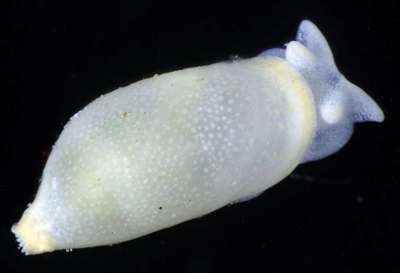
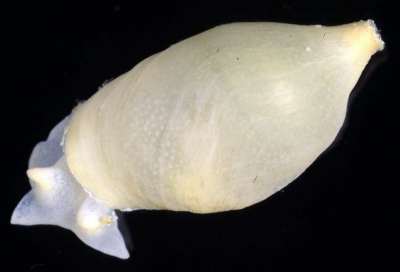
Dear Bill,
I sent you these photos of Volvatella ayakii in early May but I think they must have got lost in the system! I think this species has previously only been reported from Japan. Bob Burn found 14 specimens from sieving Caulerpa racemosa from the reef flat at Heron Island at low tide in March. They ranged in size from 4.5 to 11 mm. The first of the pictured animals was 6.5 mm (shell length 5 mm) and the other photo was 11 mm (shell length 8.5 mm). When Hamatani (1972) described this species he noted that "the body is furnished with numerous white opaque dots over the whole part under the shell and especially densely along the anterior border of the head shield, on rhinophoral-like protruberances, on the dorsal side of foot-corners, at the posterior end of the foot..." The first photo especially clearly shows these opaque white dots.
Locality: Heron Island, Great Barrier Reef, Queensland, Australia. Intertidal. Upper: Length: 6.5 mm 8 March 2005. Lower: Length: 11 mm, 16 March 2005. Photographer: Julie Marshall
-
Hamatani, I. (1972). A new species of Volvatella Pease, 1860, found in the "Caulerpan Microfauna" in the province of Kii, Middle Japan. (Opisthobranchia: Sacoglossa). Publications of the Seto Marine Biological Laboratory, 21: 13-20, Figs 1-3, Pls 2, 3.
juliemarshall@netspace.net.au
Marshall, J.G., 2005 (Sep 21) Range extension for Volvatella ayakii. [Message in] Sea Slug Forum. Australian Museum, Sydney. Available from http://www.seaslugforum.net/find/14787Dear Julie,
Sorry I didn't post your message earlier. The system didn't lose it - I just put it to one side as I wanted to check on the identity of your animals and of course I got side-tracked. What I was wondering about was the relationship between your animals and Volvatella angeliniana, which also has white spots. It is possible the small white spots in your animal are the same as the white spots in Hamatani's description, but looking at his black & white photos the white spots seem to be arranged in a couple of wide bands, one of which is associated with the gills. I am also intrigued by the faint yellowish band along the anterior mantle edge and on the posterior 'spout', and what appear to be a yellowish tip to the rhinophores. At this stage I would think that V. angeliniana is a distinct species, but perhaps it represents a juvenile stage of V. ayakii.
I am afraid I am not too sure of the identity of this species. The shell shape is very plastic, especially in preserved specimens, but it is one of the main distinguishing features mentioned by Hamatani. Animals already identified as this species from Japan, on the basis off shell shape, don't show the white spots. The white spots in Hamatani's photos seem to be the small secretory glands found in the mantle and skin of most species of this group so it is possible if they have been recently emptied, that they appear to be absent. I will keep your animals as V. ayakii, but it is possible the upper one is V. angeliniana and the lower one is V. ayakii, or even V. vigourouxi but I find identifying many of the species in this genus very problematical.
Best wishes,
Bill Rudman
RE: sacoglossan food
July 31, 2002
From: Nishina Masayoshi
Dear Bill,
I posted a message on Caulerpa ambigua - sacoglossan food" on March 23, 2002.
My information was not correct. I have since studied the algae which are used by sacoglossans as food in Hachijo Island, and found that the following species of Caulerpa are eaten.
Caulerpa webbiana f. tomentella
Caulerpa racemosa var. laete-viriens
Cauperpa racemosa var. clavifera f. macrophysa
Caulerpa okamurae
Caulepa brachypus Harvey
Halimeda discoidea Decaisne(rare)
Best Regards,
Nishina Masayoshi
nishina@wips.co.jp
Masayohi, N., 2002 (Jul 31) RE: sacoglossan food. [Message in] Sea Slug Forum. Australian Museum, Sydney. Available from http://www.seaslugforum.net/find/7529Thanks Nishina,
Bill Rudman
Volvatella ayakii - dwarf males
July 21, 2002
From: Nishina Masayoshi
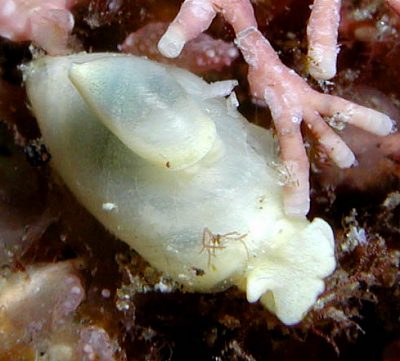
Dear Bill,
Concerning your message about 'dwarf males' in V. vigourouxi, I sometimes see Volvatella ayakii doing the same action. I was wondering what they were doing.
At Hachijo Island, Japan.
6 April, 2002
Length:10mm & 4mm
Photo by Chikako Nishina
Best Regards,
Nishina Masayoshi
nishina@wips.co.jp
Masayoshi, N., 2002 (Jul 21) Volvatella ayakii - dwarf males. [Message in] Sea Slug Forum. Australian Museum, Sydney. Available from http://www.seaslugforum.net/find/7528Thanks Nishina,
Perhaps it is a common behaviour among species of Volvatella. It's certainly something worth looking out for in future.
Best wishes,
Bill Rudman
Re: Algae in Japan
March 28, 2002
From: Nishina Masayoshi
Dear Cynthia,
Thank you for your support, but like a Bill said "Identifying foods is a difficult job"
I am afraid that I made a mistake. The algae might be Caulerpa racemosa var. occidentalis. . I have few books of algae. Do you have any document of the species? I am trying to get a correct answer now. I do hope that I can tell you the species of the algae soon.
Best Regards,
Nishina Masayoshi
http://umiushi.zive.net/ndex.html
nishina@wips.co.jp
Masayoshi, N., 2002 (Mar 28) Re: Algae in Japan. [Message in] Sea Slug Forum. Australian Museum, Sydney. Available from http://www.seaslugforum.net/find/6571Re: Caulerpa ambigua - sacoglossan food
March 27, 2002
From: Cynthia Trowbridge
Dear Nishina and Bill,
Hi. Thank you, Nishina, for all the wonderful photos of sacoglossans from Japan!! I find your messages very enjoyable and Bill's answers quite educational.
I have been reading the Japanese sacoglossan-Caulerpa literature this winter so would like to advise you of a small correction to your message.
Prof. Tadao Yoshida et al. (2000) published an update to their checklist of Japanese algae. This resource is invaluable for all the recent name changes, particularly for Caulerpa and Codium spp. because Japan is an area of incredibly wonderful diversity. For example, there are 19 spp. of Caulerpa listed and 16 spp. of Codium.
First, Caulerpa ambigua Okamura has been moved into another genus: Caulerpella ambigua (Okamura) Prud'homme van reine et Lokhorst. I will find the paper and let you know privately why it was shifted into another geuns.
Second, Caulerpa okamurae is still in Caulerpa. One confusing point is that in all the Japanese and English photo guides, the alga is called C. okamurai. But, Yoshida et al. (2000) and other Japanese phycology papers list it as okamurae. From your wonderful photos, I would guess that you have C. okamurae.
Another sacoglossan species to add to your list on this alga would be Stiliger smaragdinus. Also, I have found one Elysia setoensis on this alga but it may have been just crawling across the Caulerpa bed; the species would not eat the Caulerpa in the lab.
• Yoshida, T., Yoshinaga, K. & Nakajima, Y. (2000) Check List of Marine Algae of Japan (Revised in 2000). Jpn. J. Phycol. (Sorui), 48: 113-166.
Thank you for considering my comments and THANK YOU for the wonderful photos!
Cordially,
Cynthia
trowbric@onid.orst.edu
Trowbridge, C., 2002 (Mar 27) Re: Caulerpa ambigua - sacoglossan food. [Message in] Sea Slug Forum. Australian Museum, Sydney. Available from http://www.seaslugforum.net/find/6527Thanks Cynthia,
Identifying foods is a difficult job. We tend to think that names in other areas of biology are permanent, when in fact they are often even more unstable than in opisthobranchs. I wonder how many Caulerpa species are eaten by Stiliger smaragdinus? In Australia it is always found on a Caulerpa which has inflated 'bubbles'. In Nishina's photos the Caulerpa appears to have flattened 'bubbles'.
Best wishes,
Bill Rudman
Caulerpa ambigua - sacoglossan food
March 23, 2002
From: Nishina Masayoshi
Dear Bill,
Concerning your question 'It would be interesting to know the name of the Caulerpa that Volvatella ayakii is on'.
The name is Caulerpa ambigua(okamurae). In Hachijo Island, there are other kinds of Caulerpa but this Volvatella lives only on C. ambigua. There are at least 5 different species of sacoglossan that live on C.ambigua, sometimes a number of species are found on the same plant.
They are:
Oxynoe viridis
Lobiger viridis (L.souverbii?)
Volvatella ayakii
Tamanovalva limax and
Elysia cf. tomentosa.
Best Regards,
Nishina Masayoshi
nishina@wips.co.jp
Masayoshi, N., 2002 (Mar 23) Caulerpa ambigua - sacoglossan food. [Message in] Sea Slug Forum. Australian Museum, Sydney. Available from http://www.seaslugforum.net/find/6500Thanks Nishina,
Bill Rudman
Is this Volvatella ayakii ?
March 19, 2002
From: Nishina Masayoshi

Dear Bill,
I think that this is Volvatella ayakii Hamatani, 1972.
Date: 3 March, 2002
Location: Hachijo Island, Japan
Depth: 8m
Length: 8-10mm
Best Regards,
Nishina Masayoshi
http://umiushi.zive.net/index.html
nishina@wips.co.jp
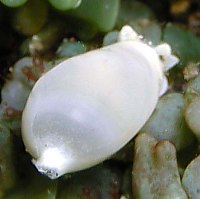

Dear Nishina,
I think this is probably Hamatani's Volvatella ayakii. He said the main distinguishing features were the shape of the shell, the external appearance of the living animal and the radular morphology. Your animals are white, and have a constriction in the shell, as described by Hamatani. However most species of Volvatella were described from the shell alone, which is a pretty unreliable character when the shell is only feebly calcified and often becomes mishapen when dried. My feeling is that we might as well call it Volvatella ayakii until the other, and much earlier, names are sorted out.
It would be interesting to know the name of the Caulerpa you found this species on. Hamatani's specimens were found on Caulerpa brachypus.
Best wishes,
Bill Rudman
